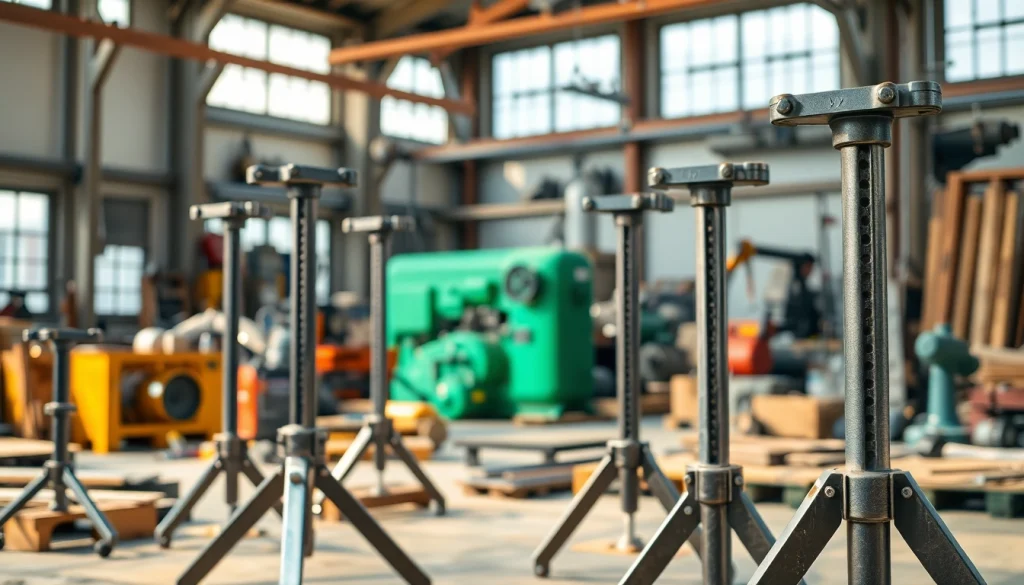
When it comes to construction and plumbing tasks, having the right tools can significantly impact efficiency and safety. Among these essential tools are pipe stands, indispensable for anyone working with various types of piping. This comprehensive guide will explore the various facets of pipe stands, from their definition and functionality to the different types available on the market and best practices for their use.
Understanding Pipe Stands
What Are Pipe Stands?
Pipe stands are supportive tools that elevate and stabilize pipes during operations like welding, cutting, or installation. These stands are typically adjustable, allowing them to accommodate different pipe sizes, weights, and job conditions. Their sturdy construction ensures that pipes remain secure, minimizing the risk of accidents or damage during handling.
Key Features and Benefits
When assessing pipe stands, several features are critical:
- Adjustability: Many pipe stands feature height adjustment options that can cater to various pipe sizes.
- Weight Capacity: Pipe stands are engineered to support substantial weights, with many capable of holding between 1,000 to 3,500 pounds.
- Durability: Typically made from high-quality materials, they are designed to withstand the wear and tear of demanding work environments.
- Portability: Some models are lightweight and designed to be easily transportable.
- Versatility: Used across multiple industries, including construction, plumbing, and manufacturing, facilitating a variety of tasks.
The combined features of adjustability, durability, and weight capacity make pipe stands a wise investment for professionals in need of reliable support solutions while working with pipes.
Common Uses in Various Industries
Pipe stands find application in various sectors. Here are some common uses:
- Construction: Supporting pipes for framing during structural projects, ensuring pipes are securely in place.
- Plumbing: Assisting in the alignment of pipes for installation, thereby ensuring proper flow and reducing leaks.
- Welding: Used to stabilize pipes at an optimal working height for welders, enhancing accessibility and precision.
- Manufacturing: Assisting in the assembly lines where pipes are a critical component of products.
Through these varied applications, pipe stands play an essential role in improving both safety and efficiency across different industries.
Types of Pipe Stands
Adjustable Pipe Stands
Adjustable pipe stands are designed to offer flexible height capability, making them suitable for pipes of varying sizes. These stands typically feature telescoping legs that allow users to set the height, which is critical in jobs that require precision and alignment. For instance, in welding, being able to adjust the height of the pipe can lead to more comfortable working positions and improved outcomes.
Heavy-Duty Jack Stands
Heavy-duty jack stands are engineered for extreme conditions and are capable of supporting very heavy loads. These stands are constructed from robust materials like steel, ensuring they can handle intense weight without compromising stability. Construction sites that regularly deal with large pipes or equipment will find heavy-duty jack stands particularly beneficial.
Portable Pipe Racks
For those needing mobility, portable pipe racks are an excellent solution. These stands are often foldable or easy to transport, allowing users to set them up on different job sites. Portability is an advantageous feature for contractors or plumbers who require flexibility in their work environments.
Choosing the Right Pipe Stand
Factors to Consider: Weight Capacity and Material
When selecting a pipe stand, two critical factors must be taken into account: weight capacity and material. Understanding these factors can help ensure that the selected model will suit the intended applications:
- Weight Capacity: Assessing the maximum load the stand can hold is imperative for safety. It’s advisable to choose stands rated for at least half the weight of the load you plan to support.
- Material: The construction material influences the durability and stability of the stand. Steel stands tend to offer higher strength and resilience compared to those made from lighter materials.
How to Measure for the Perfect Fit
To ensure the best fit for your pipes, it is essential to measure the diameter and length of the pipes you will be working with. In addition to measuring the pipe’s dimensions, consider the working height you require. This will help you select an adjustable stand that fits your needs precisely, enhancing both efficiency and safety during operations.
Comparing Price Points Across Brands
Investing in quality equipment is crucial, but it’s equally important to have a budget in mind. While comparing brands, it’s advisable to look beyond the price tag. Consider the reputation of the brand, user reviews, the warranty provided, and the stand’s features. Sometimes, opting for a slightly more expensive model can result in better performance and longevity.
Best Practices for Using Pipe Stands
Safety Measures to Implement
Safety should be paramount when using pipe stands. Here are some best practices to follow:
- Inspect Before Use: Always inspect pipe stands for damage or wear before use. Look for cracks, rust, or structural issues that could lead to failure.
- Flat Surface: Ensure that stands are placed on a stable and level surface to prevent tipping.
- Weight Distribution: Be mindful of how weight is distributed across the stand to avoid overloading and potential collapse.
- Secure Properly: If using rollers or adjustable features, ensure everything is locked in place before work commences.
Maximizing Efficiency While Working
To maximize efficiency when using pipe stands, organize your workspace. Keep tools and materials within reach to minimize unnecessary movements while working. Additionally, consider training team members on the proper techniques for setting up and utilizing pipe stands to encourage teamwork and maintain a streamlined workflow.
Maintenance Tips to Prolong Lifespan
To ensure that your pipe stands last as long as possible, regular maintenance is essential. Some tips include:
- Cleaning: Regularly clean the stands to remove debris and dirt that can cause corrosion.
- Lubrication: If your pipe stands have any moving parts, lubricate them periodically to prevent rust and ensure they operate smoothly.
- Store Properly: Always store pipe stands in a dry, cool area to prevent moisture damage.
FAQs About Pipe Stands
What Is the Purpose of a Pipe Stand?
The primary purpose of a pipe stand is to support and elevate pipes during various operations, such as cutting, welding, or assembling. They provide stability and safety, making working with pipes easier and more efficient.
How Strong Should My Pipe Stand Be?
The strength of your pipe stand should be determined based on the heaviest load it will need to support. A good rule of thumb is to select a stand capable of holding at least half the total weight of the pipe you are working with to ensure safety.
Where to Buy Quality Pipe Stands?
Quality pipe stands can be purchased from a variety of sources, including specialized construction supply stores, online retailers, and industrial equipment suppliers. Be sure to review specifications, warranty information, and customer reviews before making a decision.






